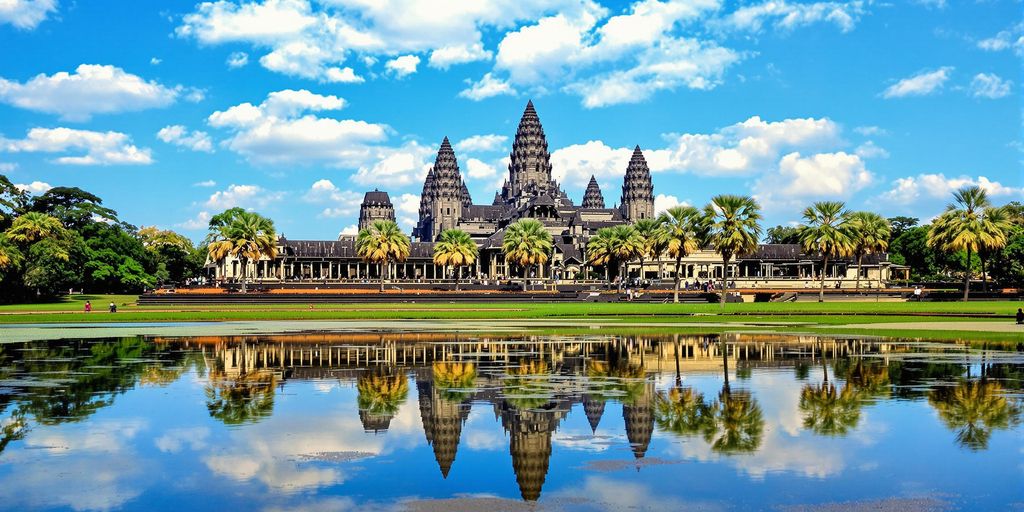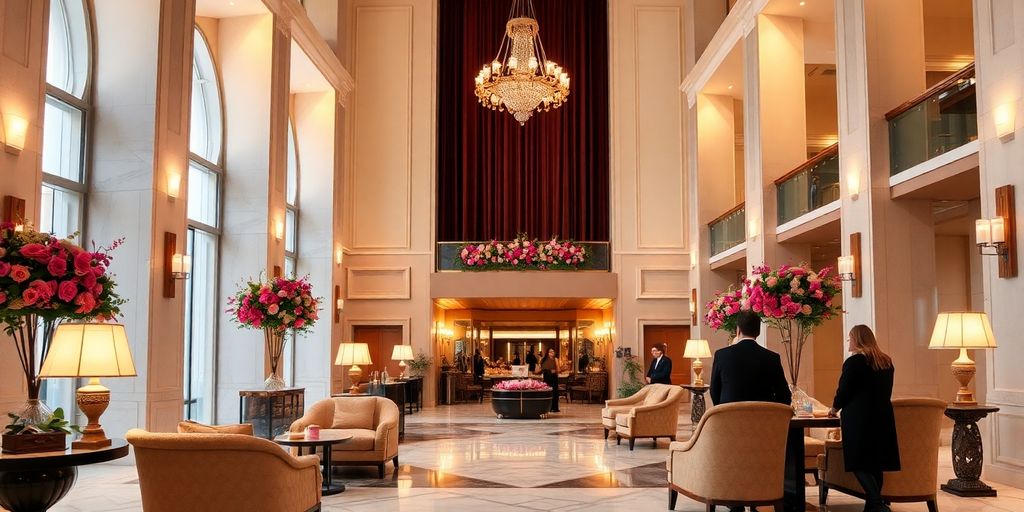Exploring the Magic of Angkor Wat

Angkor Wat is more than just a tourist spot; it’s a place where history, architecture, and spirituality collide. This ancient temple complex in Cambodia has stood the test of time, drawing millions of visitors each year. Whether you’re fascinated by its intricate carvings or its role in history, Angkor Wat offers an unforgettable journey into the heart of the Khmer Empire.
Key Takeaways
- Angkor Wat was originally built in the 12th century as a Hindu temple dedicated to Vishnu but later became a Buddhist site.
- The temple complex is a symbol of Cambodia, even appearing on the national flag.
- Its intricate bas-reliefs and towering architecture showcase the engineering brilliance of the Khmer Empire.
- Angkor Wat is a UNESCO World Heritage site and one of the most visited landmarks in the world.
- Visiting during sunrise or sunset provides the most stunning views and a peaceful atmosphere.
The Origins and History of Angkor Wat

The Vision Behind Its Construction
Angkor Wat wasn’t just another temple—it was a statement. Built in the 12th century by King Suryavarman II, this sprawling complex was dedicated to the Hindu god Vishnu. The name itself reflects its grandeur: Angkor means "city" and Wat translates to "temple." Back then, the Khmer Empire was at its peak, and this temple was designed to showcase its immense power and devotion. It wasn’t just a place of worship; it was the heart of an empire. The layout, with its precise symmetry and alignment to celestial events, was meant to symbolize the universe itself.
Transition from Hinduism to Buddhism
Over time, Angkor Wat saw a shift in its spiritual identity. Originally a Hindu temple, it began transitioning to Buddhism by the 14th century. This wasn’t a sudden change but a gradual one, reflecting Cambodia’s evolving religious landscape. Statues of Buddha were added, and Buddhist monks started using the temple for their practices. Today, it remains a sacred site for Buddhists, blending elements of both religions seamlessly.
Significance in the Khmer Empire
For the Khmer Empire, Angkor Wat was more than a temple—it was a symbol of their dominance and ingenuity. The sheer scale of its construction, using sandstone blocks transported from miles away, demonstrated their engineering prowess. It also served as a political statement, reinforcing the king’s divine right to rule. At its height, the temple complex was surrounded by a vibrant city, teeming with life and activity. While much of that has faded, the legacy of Angkor Wat as a centerpiece of Khmer culture endures.
Architectural Marvels of Angkor Wat
Intricate Bas-Reliefs and Carvings
The walls of Angkor Wat are like a giant storybook, etched with tales from ancient Hindu epics and Khmer history. These bas-reliefs stretch for miles, each panel intricately carved with scenes of gods, warriors, and celestial dancers. Every detail feels alive, as if the artisans poured their souls into the stone. The craftsmanship is so precise, you can even see the folds of clothing and the expressions on faces. It’s not just art—it’s a window into the beliefs and daily life of the Khmer Empire.
The Central Towers and Their Symbolism
The five iconic towers of Angkor Wat are more than just architectural wonders—they’re symbolic. They represent Mount Meru, the mythical home of the gods in Hindu and Buddhist cosmology. The tallest central tower rises majestically, almost like it’s reaching for the heavens. Walking through the corridors leading to these towers, you can feel the spiritual weight of the place. It’s designed to make you feel small yet connected to something much greater.
Engineering Feats of the 12th Century
Let’s talk construction. How did they manage to build something this massive in the 12th century without modern tools? The stones, some weighing tons, were transported from quarries miles away—likely floated down rivers on rafts. The precision of the alignment, the durability of the materials, and the sheer scale of the project are mind-blowing. Even today, engineers scratch their heads at how these feats were accomplished. It’s a testament to the ingenuity and determination of the Khmer people.
Exploring the Main Temples of Angkor Wat
Sunrise at the Reflecting Pool
There’s nothing quite like starting your day at Angkor Wat with a sunrise. The golden light reflecting off the temple’s iconic towers in the still water of the reflecting pool is simply magical. Arrive early—ideally before 5:30 AM—to grab a good spot. The early morning calm adds to the sense of wonder, making it a photographer’s dream and a serene moment for visitors.
Highlights of the Main Temple Complex
The main temple complex is a labyrinth of intricate carvings, steep staircases, and spacious courtyards. Don’t miss the bas-reliefs that line the outer walls, depicting scenes from Hindu epics like the Ramayana and Mahabharata. The central towers, representing Mount Meru, stand as a testament to the Khmer Empire’s architectural genius. A walk through this area can take hours, so take your time to soak in the details.
The Mystical Ta Prohm Temple
Known as the "jungle temple," Ta Prohm has a mystical vibe that’s hard to ignore. Massive tree roots have engulfed the ruins, creating a dramatic blend of nature and ancient architecture. Originally built as a Buddhist monastery, it’s one of the most photographed sites in the complex. The interplay of light, shadow, and overgrown vegetation makes it feel like stepping into another world. If you’re looking for a quieter experience, try visiting in the late afternoon when the crowds thin out.
Walking through these temples, you can’t help but feel a connection to the past. It’s as if the stones themselves hold whispers of history, waiting to be discovered.
Hidden Gems Beyond Angkor Wat
Discovering Banteay Srei
Banteay Srei, often called the "Citadel of Women," is a masterpiece of pink sandstone. Located about 30 kilometers from the main Angkor Wat complex, this temple is renowned for its incredibly detailed carvings that depict scenes from Hindu mythology. The smaller scale of the temple makes it feel more intimate, and the intricate craftsmanship is unmatched. Visiting here feels like stepping into a beautifully illustrated storybook.
The Tranquility of Preah Khan
If you’re looking for a peaceful escape, Preah Khan is your spot. This sprawling temple complex once served as a Buddhist monastery and university. Unlike the busier temples, Preah Khan offers a more serene atmosphere, with partially restored ruins surrounded by lush greenery. Wander through its corridors and discover hidden shrines and quiet courtyards—it’s a place where history and nature blend perfectly.
Lesser-Known Temples Worth Visiting
For those who crave exploration, there are plenty of lesser-known temples that deserve your attention:
- Ta Som: Famous for its picturesque tree roots enveloping the temple gate.
- Beng Mealea: A temple still largely overrun by jungle, offering a sense of adventure.
- Phnom Bok: Sitting atop a hill, this temple rewards visitors with stunning panoramic views of the Cambodian countryside.
Taking the time to explore these hidden gems not only enriches your visit but also gives you a deeper appreciation for the vastness and diversity of the Angkor archaeological park.
Cultural and Spiritual Significance of Angkor Wat
A Portal to an Ancient World
Angkor Wat isn’t just a collection of ancient stones; it’s like stepping into a time machine. Walking through its vast corridors and intricate halls, you can almost feel the whispers of the past. This temple complex served as a hub for spiritual reflection, where generations of people came to pray, ponder, and connect with something greater than themselves. It’s one of the rare places where history and spirituality meet so seamlessly.
Spiritual Practices Through the Ages
Over the centuries, Angkor Wat has transformed in its spiritual role. Initially a Hindu temple dedicated to Vishnu, it later became a Buddhist sanctuary. This transition reflects the evolving beliefs of the Khmer Empire and how religion shaped their daily lives. Monks still frequent the site today, keeping its spiritual essence alive. Visitors often describe feeling a profound sense of peace and wonder while exploring.
National Pride and UNESCO Recognition
For Cambodia, Angkor Wat is more than an architectural wonder; it’s a symbol of resilience and national pride. Despite surviving wars and centuries of natural decay, the temple stands tall, a testament to the enduring spirit of the Khmer people. Its designation as a UNESCO World Heritage site has not only ensured its preservation but also elevated its status as a global treasure. It’s a place where history, culture, and spirituality converge, leaving a lasting impression on everyone who visits.
Standing before Angkor Wat, you can’t help but feel small in the best way possible. It’s a humbling reminder of what humans can create when driven by faith and vision.
Planning Your Visit to Angkor Wat

Best Times to Visit and Avoid Crowds
Angkor Wat is breathtaking year-round, but timing your visit can make a huge difference. The dry season, from November to March, is the most popular time to explore, thanks to cooler weather and clear skies. However, this also means larger crowds. If you prefer a quieter experience, consider visiting during the shoulder months of April or October. Rain might be a factor, but the lush greenery and fewer tourists make it worthwhile.
| Season | Weather | Crowd Levels |
|---|---|---|
| November-March | Cool, dry, and pleasant | High |
| April-May | Hot and dry | Moderate |
| June-October | Rainy but lush | Low |
Essential Tips for First-Time Visitors
Making the most of Angkor Wat requires a bit of preparation. Here are some tips to help you out:
- Get the Angkor Pass: Choose between a 1-day, 3-day, or 7-day pass based on your schedule. It’s your ticket to all the temples in the complex.
- Dress Respectfully: Temples are sacred spaces. Wear lightweight clothing that covers your shoulders and knees.
- Start Early: Beat the heat and the crowds by arriving at sunrise. The morning light also makes for stunning photos.
- Hire a Guide: A knowledgeable guide can bring the history and symbolism of the temples to life.
- Stay Hydrated: Carry plenty of water. Cambodia’s heat can be intense, especially around midday.
What to Pack for Your Journey
Packing smart can make your visit much more comfortable. Here’s a quick checklist:
- Comfortable walking shoes – You’ll be covering a lot of ground.
- Sunscreen and a hat – Protect yourself from the tropical sun.
- A refillable water bottle – Many spots have refill stations.
- Bug spray – Mosquitoes can be a nuisance, especially during the rainy season.
- A lightweight scarf – Handy for temple visits or as a sun shield.
Visiting Angkor Wat is more than just a trip; it’s a journey into history, culture, and spirituality. With a little planning, you’ll leave with memories you’ll treasure for a lifetime.
The Role of Angkor Wat in Modern Cambodia
Tourism and Economic Impact
Angkor Wat is more than just a historical treasure; it is a key driver of Cambodia’s economy. Welcoming over 500,000 visitors annually, this iconic site generates significant revenue through entrance fees, local tours, and related services. Its influence on tourism cannot be overstated, as it draws travelers from all corners of the globe. This influx supports small businesses, from tuk-tuk drivers to souvenir vendors, creating a ripple effect that benefits countless families. For many, Angkor Wat isn’t just a temple—it’s a livelihood.
Preservation Efforts and Challenges
Preserving Angkor Wat is a constant balancing act. On one hand, it’s vital to maintain the integrity of this ancient site; on the other, the sheer number of visitors poses risks to its fragile structures. UNESCO designation has helped funnel resources into restoration, but challenges remain. Weather, erosion, and even modern tourism take their toll. Experts are working tirelessly to ensure future generations can marvel at this timeless wonder, but it’s no easy task.
Angkor Wat as a Symbol of Resilience
Angkor Wat stands as a testament to Cambodia’s enduring spirit. Despite centuries of neglect and the scars of war—including visible bullet holes on its outer walls—the temple complex has survived. Today, it is a source of immense national pride, symbolizing the resilience of the Cambodian people. It’s not just a monument; it’s a reminder of what the country has overcome and the strength it carries forward.
Walking through Angkor Wat, you feel the weight of history and the hope of a nation. It’s a place where the past meets the present, and both inspire the future.
Conclusion
Angkor Wat is more than just a historical site; it’s a place that stirs something deep within you. Walking through its ancient corridors, you can’t help but feel connected to the past, to the people who built it, and to the stories etched into its walls. It’s a reminder of what humans are capable of creating, even with limited tools and resources. Whether you’re there for the history, the architecture, or just the sheer sense of wonder, Angkor Wat leaves an impression that stays with you long after you’ve left. If you ever get the chance, don’t hesitate—go see it for yourself. It’s one of those rare places that truly lives up to the hype.
Frequently Asked Questions
What is Angkor Wat and why is it famous?
Angkor Wat is an ancient temple complex in Cambodia, originally built as a Hindu temple dedicated to Vishnu in the 12th century. Over time, it transitioned into a Buddhist temple. It’s famous for its grand architecture, intricate carvings, and as a symbol of Cambodia’s rich history and culture.
When is the best time to visit Angkor Wat?
The best time to visit Angkor Wat is during the dry season, which runs from November to March. The weather is cooler, making it more comfortable to explore the temples. However, these months are also the busiest, so expect larger crowds.
How much does it cost to visit Angkor Wat?
The entrance fee for Angkor Wat varies depending on the duration of your visit. A one-day pass costs $37, a three-day pass is $62, and a seven-day pass costs $72. These prices may change, so it’s good to check before your trip.
What should I wear when visiting Angkor Wat?
Visitors should dress modestly when visiting Angkor Wat. Wear clothing that covers your shoulders and knees out of respect for the sacred site. Light, breathable fabrics are ideal due to the hot weather.
Can I see Angkor Wat in one day?
While it’s possible to see the main temple in one day, Angkor Wat is part of a vast complex with many temples and sites to explore. To fully appreciate its beauty and history, a two- or three-day visit is recommended.
Is a guide necessary for visiting Angkor Wat?
A guide is not mandatory, but it can greatly enhance your experience. Guides provide historical context, share interesting stories, and help you navigate the vast temple complex efficiently.








Responses